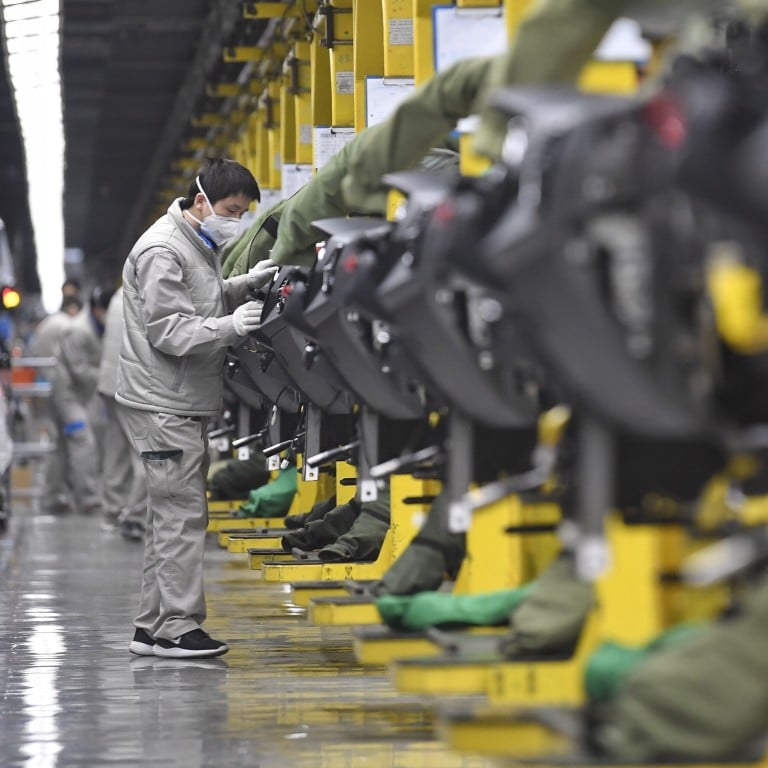
China’s 2019 GDP revised down, shrinking the base for 2020 growth calculations
- ‘Minimal’ revision in China’s GDP growth rate for last year – from 6.1 per cent to 6.0 per cent – represents a reduction of 435 billion yuan (US$67 billion) from earlier calculations
- Data adjustment puts China’s 2019 GDP at the lowest end of what had been Beijing’s official growth target range for the year
The size of China’s economy and its growth rate for 2019 are slightly smaller than Beijing previously announced, the National Bureau of Statistics (NBS) said on Wednesday after its annual revision of economic data.
The NBS statement did not say how much the revision would affect the calculation of the 2020 growth rate. However, by creating a lower base for that calculation, the revision could potentially result in a larger increase for this year than otherwise would have been expected.
The downward revision for 2019 – from an annual growth rate of 6.1 per cent to 6.0 per cent – represents an overall reduction of 435 billion yuan (US$67 billion) from earlier calculations. According to the new figures, China’s nominal gross domestic product (GDP), before being adjusted for inflation, was 98.65 trillion yuan (US$15.1 trillion) in 2019.
Changes to data in China’s manufacturing industry were said to be the major drivers of the adjustment, with the industry’s value-added output reduced by 503.8 billion yuan from earlier estimates, followed by changes to the finance, transport and construction sectors, according to the NBS website.
Analysts said that, in contrast to previous annual revisions, the revision of 2019’s GDP was relatively small and thus would have a minimal impact on the calculation of the 2020 growth rate – at most 0.1 per cent. This is due, in part, to the fact that the 2020 GDP deflator – the inflation gauge that is used to adjust nominal GDP into real GDP – is much lower than it was in 2019.
Before the pandemic, Beijing had committed to doubling the size of the economy between 2010 and 2020, requiring an annual growth rate of 6.2 per cent in 2020 to meet the goal. With growth running below that rate in late 2019, and expected to decelerate further this year, analysts had predicted that Beijing would revise up its GDP levels if necessary to meet that growth target.
In the annual GDP revision conducted in December 2019, Beijing did revise up nominal 2018 GDP by 2.1 per cent to 91.93 trillion yuan.
Dan Wang, chief economist at Hang Seng Bank (China), said the 2019 revision looks to have a bigger impact on the nation’s employment growth. Beijing set a goal of creating 9 million new urban jobs this year, compared with its goal of 11 million last year.
“By adjusting down real GDP growth, the estimated new jobs created would also be lower for that year. Then, the 2020 job market stats will look better [given the lower base],” she said.
Nevertheless, the current NBS surveyed urban unemployment rate, which stood at 5.2 per cent in November, “has underestimated the jobless situation”, she said.
A report in April by Xiong Chai, a researcher at Evergrande Think Tank, said that to keep the unemployment rate under 5.5 per cent, the country’s economy needed to grow by at least 4.4 per cent in 2020. But if this year’s growth rate was between 2 per cent and 4 per cent, the unemployment rate would reach 5.6 per cent to 6.2 per cent.
Given strong data in November and the solid growth momentum in December, Nomura chief China economist Lu Ting forecast earlier this month that China’s GDP would grow by 2.1 per cent this year.
Wang from Hang Seng Bank said the bank’s previous prediction was for growth of 1.7 per cent this year, but with the new revision it is expected to be 1.8 per cent.

